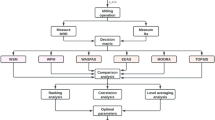Abstract
This paper presents a logical procedure to evaluate the machinability of work materials for a given machining operation. The procedure is based on a combined TOPSIS and AHP method. The proposed global machinability index helps to evaluate and rank the work materials for a given machining operation. Two examples are included to illustrate the approach.
Similar content being viewed by others
References
Hindustan Machine Tools (1980) Production technology. Tata – McGraw-Hill, New Delhi
Mills B, Redford AH (1983) Machinability of engineering materials. Applied Science, London
Trent EM (1991) Metal cutting. Butterworth-Heinemann, London
Rao RV (2002) Machinability evaluation, cutting fluid selection and failure analysis of machine tools using a unified graph theory and matrix approach. Dissertation, BITS Pilani, Rajasthan, India
Ostafev VA, Mirzaev AA, Kokarovtsev VV (1989) Fast method for determining machinability of materials. Soviet Eng Res 9(8):113–114
Notoya H, Yamada S, Yoshikawa K, Takatsuji Y (1990) Effects of tool materials on machinability of commercially pure titanium. J Japan Inst Metals 54(5):596–602
Eyada OK (1992) Reliability of cutting forces in machinability evaluation. Flexible Automat Inf Manage 20:937–946
Hung NP, Boey FYC, Khor KA, Oh CA, Lee HF (1995) Machinability of cast and powder-formed aluminium alloys reinforced with SiC particles. J Mater Process Technol 48(1):291–297
Dravid SV, Utpat LS (2001) Machinability evaluation based on the surface finish criterion. J Inst Eng (India) Product Eng Division 81(2):47–51
Jin LZ, Sandstrom R (1994) Evaluation of machinability data. J Testing Eval 22:204–210
Yoshikawa T, Miyazawa S, Mori K (1994) Machinability of Ni3Al-based intermetallic compounds. J Mech Eng Lab 48(4):190–196
Hartung PD, Kramer BM (1982) Tool wear in titanium machining. Ann CIRP 31(1):75–80
Strafford KN, Audy J (1997) Indirect monitoring of machinability in carbon steels by measurement of cutting forces. J Mater Process Technol 67(1–3):150–156
Konig W, Erinski D (1983) Machining and machinability of aluminium cast alloys. Ann CIRP 32(2):535–540
Bech HG (1963) Untersuchung der Zerspanbarkeit von Leichtmetallgulegierungen. Dissertation, RWTH, Aachen
Ezugwu EO, Wang ZM, Machado AR (1999) The machinability of nickel based alloys: a review. J Mater Process Technol 86:1–16
Choudhury A, El Baradie MA (1998) Machinability of nickel based super alloys: a general review. J Mater Process Technol 77(1–3):278–284
Ezugwu EO, Bonney J, Yamane Y (2003) An overview of the machinability of aeroengine alloys. J Mater Process Technol 134:233–253
Gupta SK, Dana SN (1995) Systematic approach to analyzing the manufacturability of machined parts. Comput Aided Des J 27:323–342
Sandstrom R, Grahn B (1986) The assessment and evaluation of property data for materials selection purposes. Mater Des J 7:198–204
Leisk G, Saigal A (1992) Machinabiliy of alumina/aluminum metal matrix composites. In: Proceedings of the International Symposium on Advances in Production and Fabrication of Light Metals and Metal Matrix Composites, Edmonton, Alberta, Canada, pp 673–687
Hamann JC, Grolleau V, Maitre FL (1996) Machinability improvement of steels at high cutting speeds – study of tool/work material interaction. Ann CIRP 45:87–92
Hong H, Riga AT, Cahoon JM, Scott CG (1993) Machinability of steels and titanium alloys under lubrication. Wear 162:34–39
Carpenter ID (1996) Machinability assessment and tool selection for milling. Dissertation, University of Durham, Durham
Seo Y, Ramulu M, Kim D (2003) Machinability of Ti alloys on the abrasive waterjet machining process. In: Proceedings of the Institution of Mechanical Engineers, Part B J Eng Manuf 217:1709–1721
Davim JP, Reis P (2004) Machinability study on composite (polyetheretherketone reinforced with 30% glass fibre-PEEK OKGF 30) using polycrystalline diamond (PCD) and cemented carbide (K20) tools. Int J Adv Manuf Technol 23(5–6):412–418
Malakooti B, Wang J, Tandler EC (1990) Sensor based accelerated approach for multi-attribute machinability and tool life evaluation. Int J Prod Res 28:2373–2392
Enache S, Strajescu E, Opran C, Minciu C, Zamfirache M (1995) Mathematical model for the establishment of the materials machinability. Ann CIRP 44:79–82
Ong SK, Chew LC (2000) Evaluating the manufacturability of machined parts and their setup plans. Int J Prod Res 38(11):2397–2415
Rao RV, Gandhi OP (2002) Digraph and matrix methods for the machinability evaluation of work materials. Int J Mach Tools Manuf 42(3):320–330
Hwang CL, Yoon K (1982) Multiple attribute decision-making – methods and applications – a state of art survey. Springer, Berlin Heidelberg New York
Yoon YP, Hwang CL (1995) Multiple attribute decision-making. SAGE Publications, Beverly Hills, CA
Saaty TL (1980) Analytic hierarchy process. McGraw-Hill, New York
Saaty TL (1994) Fundamentals of decision-making and priority theory with AHP. RWS, Pittsburgh, PA
Author information
Authors and Affiliations
Corresponding author
Rights and permissions
About this article
Cite this article
Venkata Rao, R. Machinability evaluation of work materials using a combined multiple attribute decision-making method. Int J Adv Manuf Technol 28, 221–227 (2006). https://doi.org/10.1007/s00170-004-2348-4
Received:
Accepted:
Published:
Issue Date:
DOI: https://doi.org/10.1007/s00170-004-2348-4




